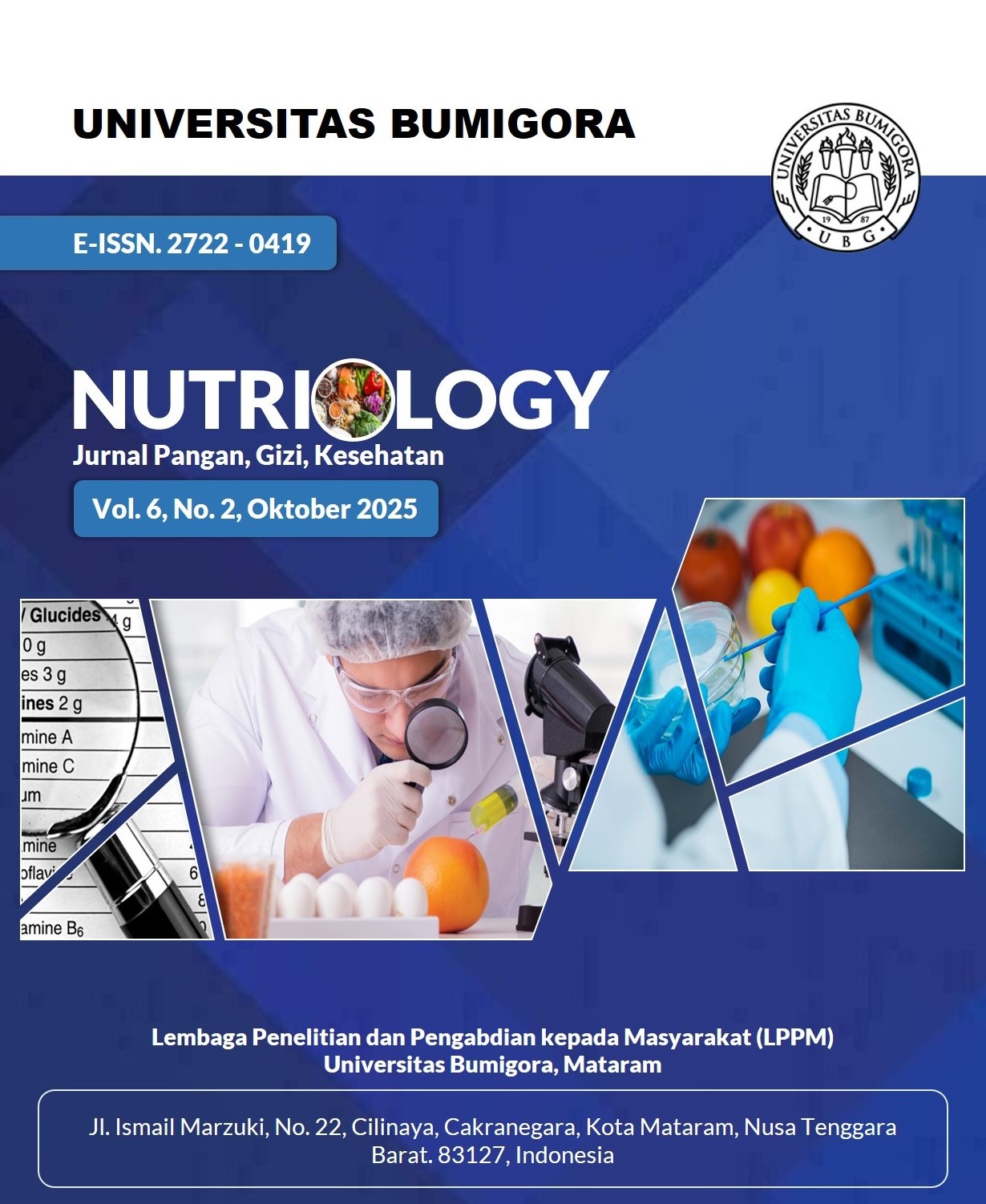Kandungan Flavonoid dan Fenol Es Krim Buah Naga berbasis Tepung Daun Kelor untuk Remaja Putri
DOI:
https://doi.org/10.30812/nutriology.v6i2.5241Kata Kunci:
anemia, buah naga, daun kelor, es krim, remaja putriAbstrak
Adolescent anemia is characterized by iron deficiency associated with menstruation and unbalanced nutrient intake. Red dragon fruit and moringa leaf flour are rich in iron, flavonoids, and phenolic compounds, which possess antioxidant properties and may help prevent anemia. Both ingredients can be developed into snack products such as ice cream, which is popular among adolescents. The objective of this study was to analyze the total flavonoid and total phenolic contents in red dragon fruit ice cream with the addition of moringa leaf flour. This research employed a Completely Randomized Design (CRD) with five formulations and two replications. Chemical analysis and The ice cream was prepared at the Laboratory of Aisyah University, Pringsewu, in January 2025. Data were analyzed using One-Way ANOVA followed by Duncan’s multiple range test. The results showed significant differences (p < 0.05) among the formulations. The highest total flavonoid content was observed in formulation F4 (10%) with 0.53 mg quercetin equivalent per gram (p = 0.001). The highest total phenolic content was found in formulation F0 (0%) with 5.48 mg gallic acid equivalent per gram (p = 0.002). In conclusion, the addition of up to 10% moringa leaf flour in red dragon fruit ice cream increased the total flavonoid content but decreased the total phenolic content. Therefore, this product has potential as a functional food rich in antioxidant compounds that may benefit adolescent girls.
Referensi
[1] Y. Aulya, J. A. Siauta, and Y. Nizmadilla, “Analisis Anemia pada Remaja Putri,” Jurnal Penelitian Perawat Profesional, vol. 4, no. 4, pp. 1377–1386, 2022, doi: 10.37287/jppp.v4i4.1259.
[2] E. R. Astuti, “Literature Review: Faktor-Faktor Penyebab Anemia Pada Remaja Putri,” Jambura Journal of Health Science and Research, vol. 5, no. 2, pp. 550–561, 2023, doi: 10.35971/jjhsr.v5i2.17341.
[3] D. C. Resmi and F. T. Setiani, “Literatur Review: Penerapan Terapi Non Farmakologis Terhadap Peningkatan Kadar Hemoglobin Pada Remaja Putri Dengan Anemia,” Jurnal Ilmiah Kesehatan, vol. 10, no. 2, pp. 44–50, 2020, doi: 10.32699/jik.v10i2.1526.
[4] World Health Organization (WHO), “World Health Statistics 2021: Monitoring Health for the SDGs,” Geneva, 2021.
[5] Kemenkes RI, “Remaja Putri Sehat Bebas Anemia di Masa Pandemi Covid-19,” Jakarta, 2021.
[6] Kemenkes RI, “Riskesdas 2018: Riset Kesehatan Dasar,” Jakarta, 2018.
[7] F. H. Salsabilla, D. E. Yanti, and F. Ekasari, “Pendidikan Media Video Terhadap Pengetahuan Anemia Pada Remaja Putri,” Surya Medika, vol. 19, no. 02, pp. 91–95, 2024, doi: 10.32504/sm.v19i2.950.
[8] S. O. Ainiyati, N. Nurdiana, and N. A. R. Hastuti, “Literature Review: Pengaruh Pemberian Bit (Beta Vulgaris L.) Terhadap Kadar Hemoglobin,” Journal of Issues in Midwifery, vol. 6, no. April, pp. 10–25, 2022, doi: 10.21776/ub.JOIM.2022.006.01.2.
[9] W. Ntia, Tamrin, and M. Syukri S, “Pengaruh Penambahan Filtrat Kulit Buah Naga Merah (Hylocereus Polyrhizus) Pada Sirup Air Kelapa (Cocos Nucifera L.) Terhadap Nilai Organoleptik Dan Aktivitas Antioksidan,” Jurnal Sains dan Teknologi Pangan, vol. 4, no. 5, p. 172, 2019, doi: 10.21776/ub.jpa.2018.006.02.2.
[10] N. K. A. Septiani, I. M. O. A. Parwata, and A. A. B. Putra, “Penentuan Kadar Total Fenol, Kadar Total Flavonoid dan Skrining Fitokimia Ekstrak Etanol Daun Gaharu (Gyrinops versteegii),” Jurnal Matematika, Sains, dan Pembelajarannya, vol. 12, no. 1, pp. 78–89, 2018, doi: 10.23887/wms.v12i1.13868.
[11] A. Wulandari, Y. Farida, and S. Taurhesia, “Perbandingan Aktivitas Ekstrak Daun Kelor Dan Teh Hijau Serta Kombinasi Sebagai Antibakteri Penyebab Jerawat,” Jurnal Fitofarmaka Indonesia, vol. 7, no. 2, pp. 23–29, 2020, doi: 10.33096/jffi.v7i2.535.
[12] R. Hipni et al., “Phytochemical Screening and Antioxidant Activity in Dragon Fruit Plant Extracts as Immunomodulators in Pregnant Women,” Pharmacognosy Journal, vol. 15, no. 6, pp. 999–1004, 2023, doi: 10.5530/pj.2023.15.184.
[13] F. Gasperz and V. Lalopua, “Edukasi Pembuatan es Krim rumput laut Eucheuma Cottonii Di Jemaat GKMI Ambon,” BALOBE: Jurnal Pengabdian Kepada Masyarakat, vol. 2, no. 2, pp. 67–73, 2023, doi: 10.30598/balobe.2.2.2023.
[14] B. Moyo, P. J. Masika, A. Hugo, and V. Muchenje, “Nutritional characterization of Moringa ( Moringa oleifera Lam .) leaves,” African Journal of Biotechnology, vol. 10, no. 60, pp. 12925–12933, 2011, doi: 10.5897/AJB10.1599.
[15] Z. Islam, S. M. R. Islam, F. Hossen, K. Mahtab-Ul-Islam, M. R. Hasan, and R. Karim, “Moringa oleifera is a Prominent Source of Nutrients with Potential Health Benefits,” International Journal of Food Science, vol. 2021, no. July 2015, p. 11, 2021, doi: 10.1155/2021/6627265.
[16] R. Peñalver, L. Martínez‐zamora, J. M. Lorenzo, G. Ros, and G. Nieto, “Nutritional and Antioxidant Properties of Moringa oleifera Leaves in Functional Foods,” Foods, vol. 11, no. 8, pp. 1–13, 2022, doi: 10.3390/foods11081107.
[17] D. F. Nishikito et al., “Anti-Inflammatory, Antioxidant, and Other Health Effects of Dragon Fruit and Potential Delivery Systems for Its Bioactive Compounds,” Pharmaceutics, vol. 15, no. 1, pp. 1–38, 2023, doi: 10.3390/pharmaceutics15010159.
[18] M. S. Moharam, M. Y. El-Hawary, S. A. Awad, and D. A. Amer, “Development of Functional Ice Cream Fortified with Spirulina (Arthrospira platensis): Improvements in Nutritional and Antioxidant Properties,” Journal of Sustainable Agricultural and Environmental Sciences, vol. 4, no. 3, pp. 95–102, 2025, doi: 10.21608/jsaes.2025.410814.1153.
[19] A. Pareek et al., “Moringa oleifera: An Updated Comprehensive Review of Its Pharmacological Activities, Ethnomedicinal, Phytopharmaceutical Formulation, Clinical, Phytochemical, and Toxicological Aspects,” International Journal of Molecular Sciences, vol. 24, no. 3, pp. 1–36, 2023, doi: 10.3390/ijms24032098.
[20] D. W. Balebu et al., “The Miracle of Moringa Oleifera Leaves for the Prevention of Anemia: A Literature Review,” Pharmacognosy Journal, vol. 15, no. 6, pp. 1258–1261, 2023, doi: 10.5530/pj.2023.15.228.
[21] W. Qi, W. Qi, D. Xiong, and M. Long, “Quercetin: Its Antioxidant Mechanism, Antibacterial Properties and Potential Application in Prevention and Control of Toxipathy,” Molecules, vol. 27, no. 19, pp. 1–16, 2022, doi: 10.3390/molecules27196545.
[22] Smeea Fatima and Dr. Hafiz Muhammad Ali Haider, “Effectiveness of moringa oleifera to enhance the haemoglobin concentration in body: A systematic review,” Pioneer Journal of Biostatistics and Medical Research, vol. 1, no. 4, pp. 11–18, 2024, doi: 10.61171/v01.04.38.
[23] Z. Chen, B. Zhong, C. J. Barrow, F. R. Dunshea, and H. A. R. Suleria, “Identification of phenolic compounds in Australian grown dragon fruits by LC-ESI-QTOF-MS/MS and determination of their antioxidant potential,” Arabian Journal of Chemistry, vol. 14, no. 6, p. 103151, 2021, doi: 10.1016/j.arabjc.2021.103151.
[24] F. Shahidi and C. S. Dissanayaka, “Phenolic-protein interactions: insight from in-silico analyses – a review,” Food Production, Processing and Nutrition, vol. 5, no. 1, p. 21, 2023, doi: 10.1186/s43014-022-00121-0.
[25] K. Shah, J. Chen, J. Chen, and Y. Qin, “Pitaya Nutrition, Biology, and Biotechnology: A Review,” International Journal of Molecular Sciences, vol. 24, no. 18, pp. 1–28, 2023, doi: 10.3390/ijms241813986.
[26] M. Pérez, I. Dominguez-López, and R. M. Lamuela-Raventós, “The Chemistry Behind the Folin-Ciocalteu Method for the Estimation of (Poly)phenol Content in Food: Total Phenolic Intake in a Mediterranean Dietary Pattern,” Journal of Agricultural and Food Chemistry, vol. 71, no. 46, pp. 17543–17553, 2023, doi: 10.1021/acs.jafc.3c04022.
Unduhan
Diterbitkan
Terbitan
Bagian
Lisensi
Hak Cipta (c) 2025 Adelia Yustika, Dera Elva Junita, Desti Ambar Wati

Artikel ini berlisensi Creative Commons Attribution 4.0 International License.










